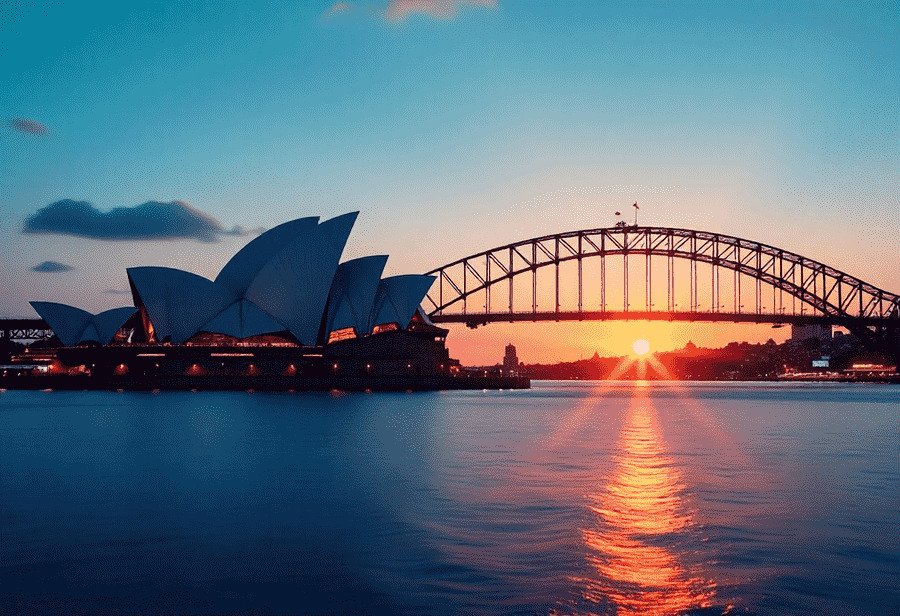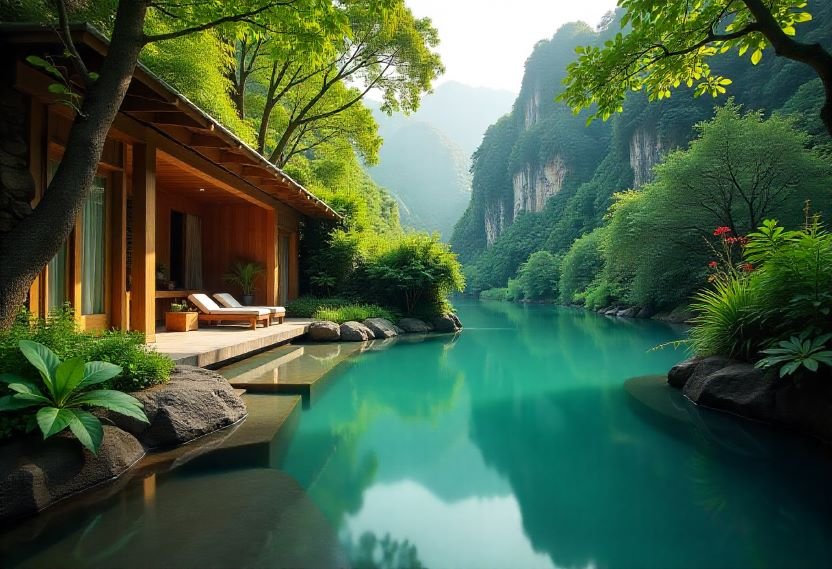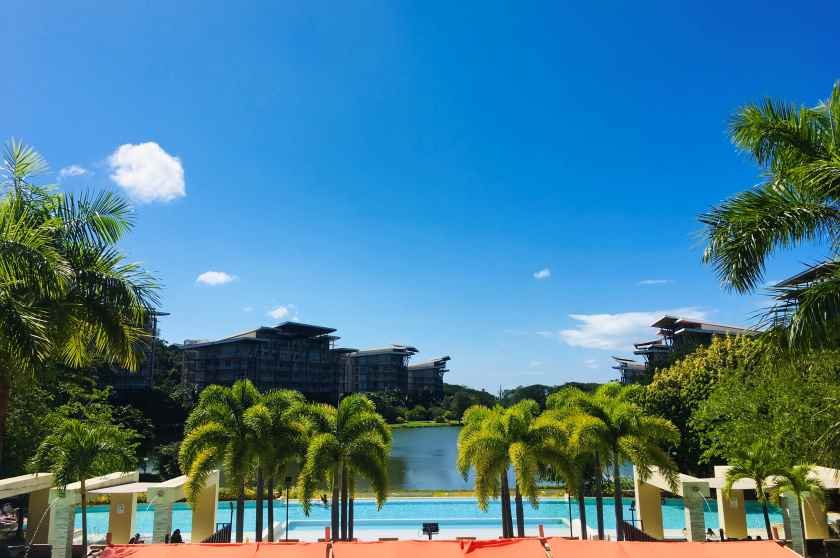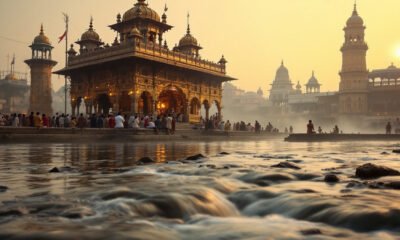Wellness Travel
Australia, Japan, Iceland, Italy, Thailand, Mexico, South Korea, Saudi Arabia And More Supercharge A Wellness Travel Explosion Now Worth Over One Trillion Dollars

Monday, July 28, 2025
Australia, Italy, Japan, Thailand, Mexico, South Korea, Saudi Arabia, and Iceland are at the forefront of a global travel transformation, spearheading an explosive rise in wellness tourism that’s redefining the way the world experiences holidays. What was once a niche has become a megatrend, with travelers now seeking mindfulness, rejuvenation, and holistic well-being over traditional sightseeing. This unstoppable momentum is propelling the wellness travel industry toward an astonishing value of one point three five trillion dollars, as nations across the globe compete to craft soul-nourishing escapes and immersive healing journeys unlike anything seen before.
Australia’s Peninsula Hot Springs and the Global Rise of Wellness Travel
Two brothers in Australia set out with a modest vision 20 years ago—creating a thermal bathing experience on a quiet patch of land in Victoria’s Mornington Peninsula. Surrounded by grassy paddocks, the concept was simple: an outdoor bathing retreat where people could unwind and connect with nature.
Fast forward two decades, and that humble project has evolved into Peninsula Hot Springs, one of the most revered wellness destinations in the world. This transformation mirrors the dramatic global shift toward wellness tourism—a fast-growing movement where travel meets self-care, balance, and mental restoration.
Why Wellness Travel Is Booming
The way people travel has fundamentally changed. Rather than chasing packed itineraries or lounging aimlessly on beach holidays, modern travelers are looking for depth, rejuvenation, and intention. Wellness travel responds to this need by offering holistic experiences that refresh both body and mind.
Post-pandemic consciousness has further fueled this trend. The global health crisis underscored the importance of physical and emotional well-being, creating lasting shifts in travel behavior. As a result, wellness tourism has seen massive growth. The industry is forecasted to reach USD 1.35 trillion by 2028, more than double its size in recent years.
Travel is no longer seen as a luxury—it’s increasingly viewed as a way to reset, recharge, and build resilience.
Wellness Is the New Standard
As interest grows, the hospitality industry is reimagining what a vacation can offer. Wellness is becoming a core part of the travel experience, not just an optional add-on. Hotels are integrating guided meditation and yoga into in-room TV systems, offering custom sleep and nutrition programs, and curating entire wellness itineraries.
Tour operators are adapting too. G Adventures, for instance, has developed wellness-focused tour categories that combine mindful movement, cultural exploration, and relaxation. Even family travel is embracing the trend. In Phuket, a hotel now offers child-friendly wellness programs—complete with spa experiences, Muay Thai training, healthy cooking classes, and eco-learning activities.
These efforts reflect a larger industry pivot: today’s traveler values experiences that support long-term health and inner peace.
Wellness Without the High Price Tag
Wellness tourism may conjure images of luxury spa resorts or high-end yoga retreats, but it doesn’t have to be expensive. In fact, younger travelers—especially Millennials and Gen Z—are proving that meaningful wellness experiences can be accessible and affordable.
Digital detox getaways, sober retreats, camping escapes, forest therapy walks, and mindfulness weekends all fall under the wellness travel umbrella. They may not come with marble floors and gourmet cuisine, but they offer the real essence of restoration.
A growing majority of Gen Z travelers (about 73%) now say they prioritize wellness benefits like relaxation and self-care when planning holidays. These travelers are more interested in how a trip makes them feel than what they can post on social media afterward.
Destinations such as Bali, Thailand, and Mexico have embraced this shift by offering affordable wellness retreats that blend yoga, meditation, detox, and cultural immersion.
From Local Retreat to Global Leader
Peninsula Hot Springs stands as a symbol of wellness travel’s evolution. What began as a single pool and café now spans a large property with spa facilities, hot springs, wellness classes, eco-lodges, and cultural experiences. The focus remains on harmony with nature and healing through simplicity.
This Australian success story is just one example of how wellness tourism is becoming an essential part of how people experience the world. More than just vacations, these journeys offer transformation.
The Next Wellness Hotspots
As the wellness wave spreads, several destinations are emerging as global leaders in the space:
- South Korea: Known for temple stays, herbal medicine, skincare rituals, and forest therapy, South Korea blends ancient traditions with modern wellness innovation.
- Italy: Beyond its food and history, Italy offers agritourism stays, natural hot springs, and wellness experiences focused on balance, nutrition, and the joy of slow living.
- Japan: With its famous onsen culture, Zen retreats, tea ceremonies, and forest bathing, Japan delivers peace and introspection in every region.
- Saudi Arabia: As tourism opens up, Saudi Arabia is investing in wellness resorts near the Red Sea, desert meditation experiences, and sustainable, eco-driven luxury.
- Iceland: A sanctuary of geothermal pools, clean air, and dramatic landscapes, Iceland is ideal for cold plunges, natural detox, and mental clarity.
Looking Ahead
The future of travel is not just about where you go, but how you feel when you get there—and how you feel when you return. Wellness tourism isn’t a passing trend; it’s a reflection of global values shifting toward health, mindfulness, and meaningful connection.
Australia, Italy, Japan, Thailand, Mexico, South Korea, Saudi Arabia, and Iceland are igniting a global shift in tourism as wellness travel surges toward a monumental one point three five trillion dollar valuation. This megatrend is redefining vacations into transformative journeys of healing, purpose, and rejuvenation.
Whether it’s soaking in thermal waters in Australia, meditating in a Japanese forest, or walking barefoot on a Mexican beach, wellness travel is guiding the world into a more balanced way to explore.
Wellness Travel
Sports Tourism Trends in 2025: Wellness, Adventure, and New Sports Experiences Across UK, US, and Asia

Monday, July 28, 2025
In 2025, sports tourism is experiencing a major boom, with travelers from around the world seeking more immersive, active, and socially conscious travel experiences. This growing trend is seen across multiple continents, with notable interest from Europe, the US, and Asia. From marathons in eco-friendly cities to triathlon camps and wellness retreats, sports tourism is evolving into a multi-faceted industry where travelers aim to blend their love for sport with cultural experiences and sustainability. The rise of “purpose-driven” travel is one of the standout trends for the year, as both fans and athletes are more concerned about the impact of their travel choices, seeking destinations that prioritize sustainability, local culture, and wellness.
This evolution in sports tourism reflects a broader shift in global travel habits. No longer just about watching events or achieving personal goals, the new generation of sports travelers is increasingly looking for ways to engage in active, meaningful experiences. Whether it’s exploring a new destination through a cycling tour or attending a global sports event, these travelers are on a quest for unforgettable experiences that go beyond traditional leisure travel.
Purpose-Driven Travel and Sustainable Sports Tourism
One of the most significant trends in sports tourism in 2025 is the rise of purpose-driven travel. Travelers are increasingly focused on combining their love for sport with their desire to support sustainability and local cultures. This growing demand for eco-conscious sports tourism can be seen in the surge of marathons held in environmentally aware cities, triathlon camps in nature reserves, and community-led surf retreats.
For instance, marathons in destinations like New York, Berlin, and London are drawing not only competitive athletes but also tourists who are attracted to the cultural richness and sustainability efforts of these cities. In addition, countries like Iceland, known for their eco-tourism initiatives, are becoming top choices for nature-oriented sports events such as trail running and endurance cycling.
The connection between travel, fitness, and sustainability is no longer a niche trend but is becoming the standard for many sports enthusiasts. As more cities and destinations integrate sustainability into their sports tourism offerings, the industry is poised to grow with a strong emphasis on responsible travel.
Adventure Sports: A Growing Focus on Personal Achievement
Adventure and endurance sports are rapidly gaining traction in 2025, offering travelers the chance to challenge themselves physically while exploring new environments. High-demand activities such as multi-day cycling tours, trail running, and triathlons are increasingly popular, with destinations worldwide offering specialized events to cater to this growing segment of sports tourists.
These activities are appealing not only for their physical challenges but also for the outdoor escapism they provide. Athletes and recreational adventurers alike are flocking to remote, scenic locations that offer both a sense of accomplishment and a connection to nature. From the mountain trails of the Swiss Alps to the coastal cycling routes of the US West Coast, these destinations are becoming hubs for fitness enthusiasts seeking new personal goals.
In countries like the US and Europe, cycling and trail running events are becoming integral to the local tourism economy, bringing in visitors who spend not just on race entry fees but also on accommodations, local tours, and dining. These experiences are not just about the sport; they offer travelers the chance to immerse themselves in the local culture, explore hidden gems, and enjoy the serenity of nature.
Emerging Sports: The Growth of Padel and Pickleball
The surge in popularity of sports like padel and pickleball is shaping the landscape of sports tourism, particularly in Europe and the Middle East. These sports, which are seen as more accessible alternatives to traditional tennis, have inspired a new wave of regional events and sports holidays. Padel, in particular, is experiencing a rapid rise in destinations such as Spain, where it was first popularized, and in countries like the UAE, where it has been embraced as a leisure activity for both locals and tourists.
Destinations such as Marbella in Spain are now key spots for tourists seeking to participate in padel-themed holidays, offering everything from professional tournaments to leisure play. Padel resorts and courts are being built in these regions to cater to the growing demand, offering tourists the chance to not only enjoy the sport but also experience the local culture and landscapes.
Pickleball, another fast-growing sport, is beginning to make waves in destinations like Florida, known for its active sports culture. Resorts and vacation spots are incorporating pickleball courts into their amenities, attracting tourists who are eager to try something new while on holiday. The rise of these sports is reshaping the sports tourism sector, creating a niche market for travelers who want to participate in recreational sports in some of the world’s most desirable destinations.
Luxury Sports Tourism: Exclusive Experiences for the Elite
Luxury sports tourism is also seeing significant growth, with affluent travelers increasingly seeking exclusive, experience-led holidays centered around high-profile sporting events. This trend is evident in destinations that host prestigious events such as Formula 1 races, golf tournaments, and tennis championships. High-end tourism companies are offering bespoke packages that combine luxury accommodations, private access to events, and once-in-a-lifetime experiences.
For example, destinations like Monaco and Abu Dhabi, home to major Formula 1 races, are attracting wealthy travelers who seek not only the thrill of the sport but also privacy, exclusive services, and cultural immersion. The demand for such high-end packages is soaring, with more and more travelers looking to attend these global events in style, enjoying personalized experiences and VIP treatment throughout their trips.
The rise of “quiet luxury,” where less-traveled routes and hidden destinations are explored in private, also plays a significant role in luxury sports tourism. High-end travelers are increasingly seeking privacy and exclusivity, bypassing the crowds in favor of more intimate and tailored experiences.
Technological Innovation in Sports Tourism
Technology is playing a pivotal role in reshaping sports tourism in 2025, making travel planning and event participation more seamless than ever before. Dynamic ticket-travel bundles, app-based fan experiences, and AI-curated itineraries are all helping to improve convenience for both sports fans and participants.
For example, dynamic ticketing systems allow travelers to purchase tickets to events and travel packages in one transaction, making it easier for fans to attend global sporting events without the hassle of separate bookings. App-based fan experiences provide real-time access to event information, exclusive behind-the-scenes content, and even virtual meet-and-greets with athletes, enhancing the fan experience from start to finish.
Moreover, AI-driven platforms are beginning to offer personalized itineraries for sports travelers, suggesting events, destinations, and activities based on individual preferences. This level of customization is attracting a growing number of travelers, particularly those who value convenience and the ability to maximize their time and experiences while on the road.
Wellness and Outdoor Activities: Combining Sport with Relaxation
Another key trend in 2025 sports tourism is the growing intersection of sports and wellness. Wellness retreats are becoming increasingly popular, especially those that offer a combination of physical activity and relaxation. From hiking and cycling tours to yoga and spa retreats, travelers are increasingly looking to combine fitness with rejuvenation, seeking experiences that nurture both the body and mind.
The popularity of wellness tourism is leading to the rise of sports holidays that offer physical activities such as running, cycling, or even skiing, alongside relaxation and mindfulness practices. These trips cater to travelers who seek a holistic approach to fitness, combining active pursuits with opportunities for rest, recovery, and well-being.
Conclusion: A New Era for Sports Tourism
The sports tourism industry in 2025 is experiencing a renaissance, driven by a growing interest in fitness, adventure, and exclusive sports experiences. From eco-conscious marathons to luxury events like Formula 1 races, the sector is evolving to meet the diverse demands of modern travelers. As sports tourism continues to grow, it will shape the future of global travel, offering opportunities for active travelers to explore new destinations, challenge themselves, and make a positive impact on the world around them.
In the coming years, sports tourism will not only be about watching events or participating in races; it will be about connecting with the culture, the people, and the environment of the destinations travelers visit. Whether it’s through immersive wellness retreats, adventure sports, or exclusive high-end experiences, the future of sports tourism is bright and filled with possibilities for both athletes and leisure travelers alike.
Wellness Travel
Wellness Tourism Continues to Soar by Seven Point Three Precent, 2034: Top Destinations, Key Drivers, and Future Trends

Monday, July 28, 2025
In recent years the wellness tourism industry has seen substantial growth as increasingly more travelers look for experiences that provide more than just relaxation, but rejuvenation and whole body health as well. As we prioritize mental health, physical wellness, and spiritual harmony, wellness tourism is responding by organizing retreats and adventures that feed our body, mind, and soul.
In essence, wellness tourism is not a fad but rather an evolution in the way we travel. Travel used to be about discovery and play, but more and more, it has become a time to make health a priority. The world-wide wellness tourism market was worth $814.6 billion in 2024, with an anticipated annual growth of 7.3%, to reach approximately $1.66 trillion by 2034. This expansion demonstrates the growing popularity of experiences which intertwine rest and relaxation while travelling, with the benefit of natural holistic wellness healing.
What Is Wellness Tourism?
Wellness travel is travel that prioritizes well-being. Unlike standard tourism, which is often rooted in activities such as sight-seeing or relaxation, wellness tourism reaches for the fiber-rejuvenating needs of the tourist. From luxury spa getaways to yoga camps, fitness cruises, detox resorts and everyone in between, the wellness tourism sector encompasses a range of offerings aimed at bettering physical, mental, and even spiritual health.
Wellness tourism can be classified into two ways: Primary wellness tourism and Secondary wellness tourism. Primary wellness tourism is when the purpose of the trip is to concentrate on health and wellness, as you would on a detox escape or during a yoga retreat. Secondary wellness tourism, on the other hand, describes travelers who include wellness experiences as a component of a more general travel experience, such as enjoying a spa day while on a sightseeing vacation.
The growing trend of integrating wellness into travel is a response to increasing awareness about mental health, stress management, and self-care. People are looking for ways to escape the fast pace of modern life and reconnect with themselves through practices that promote a balanced lifestyle.
Wellness Tourism Market Growth and Trends
For one, more folks are realising how important it is to lead a healthy life, and it’s not just about physical health; it goes hand in hand with mental health. Global stress and anxiety levels and mental health issues have never been higher, and wellness retreats are becoming a lot of people’s go-to for stress relief.
Better access to health and wellness facilities and services is also driving the trend. Technology is making it possible for travelers to monitor their journey to wellness through wearables and apps, offering them greater influence over their health while traveling. What’s more, the growth of virtual wellness programs has made it more accessible for people to take part in health and wellness without stepping outside their door. But, physical retreats continue to be all the rage and provide a deeper, more immersive experience.
The demand for personalized wellness experiences is on the rise. Consumers expect wellness providers to offer tailor-made programs that address their specific health concerns, whether it’s fitness training, mindfulness practices, or a customized detox program. This growing expectation for personalized services is shaping how wellness tourism providers operate and design their offerings.
Leading Destinations in Wellness Tourism
Several countries have embraced wellness tourism and are becoming leading destinations for health-conscious travelers. These destinations offer a combination of luxurious facilities, natural beauty, and a focus on sustainability, making them ideal for wellness seekers.
- Bali, Indonesia: Known for its spiritual and calming atmosphere, Bali offers a wide range of wellness retreats focusing on yoga, meditation, and spiritual healing. The island’s lush landscapes and serene beaches provide the perfect backdrop for relaxation and rejuvenation.
- Thailand: Thailand has long been a top destination for wellness tourism due to its extensive wellness offerings, including traditional Thai massage, detox retreats, and luxury spas. Resorts such as Chiva-Som in Hua Hin provide comprehensive wellness programs that integrate fitness, spa treatments, and nutrition.
- Switzerland: Switzerland’s stunning Alpine landscape provides a serene setting for wellness retreats. The country is home to high-end spas and wellness hotels, with many offering treatments that blend modern medicine and natural healing methods.
- India: India is a historical hub for wellness tourism, particularly in the field of Ayurveda, a traditional healing system that uses herbal medicine and yoga. States like Kerala are famous for their Ayurvedic treatments, with wellness centers offering deep rejuvenation experiences that combine health and spirituality.
- Costa Rica: Known for its biodiversity and lush rainforests, Costa Rica offers wellness retreats that focus on eco-friendly and nature-based therapies. Travelers can immerse themselves in nature while receiving treatments designed to promote physical and mental well-being.
- United States: The U.S. is home to renowned wellness resorts like Canyon Ranch and Miraval, which offer customized health programs, fitness retreats, and holistic healing therapies. These luxury wellness resorts are designed to cater to travelers seeking both relaxation and personal growth.
Factors Driving the Wellness Tourism Boom
The rapid growth of wellness tourism can be attributed to several key factors:
- Health-Conscious Travelers: As health becomes a higher priority for many, people are seeking vacation options that offer more than just relaxation. Wellness retreats provide a way to focus on both mental and physical health while enjoying a vacation.
- Increased Stress and Mental Health Awareness: With rising levels of stress, anxiety, and depression, wellness tourism offers individuals a chance to reset and recover. Many wellness resorts provide programs specifically tailored to stress management and mental well-being.
- Technology Integration: The incorporation of technology, such as fitness apps and wearables, has made it easier for people to track their wellness journey. These innovations have made wellness tourism more accessible, allowing travelers to monitor their progress even during their vacation.
- Sustainability and Eco-Consciousness: More travelers are seeking destinations that prioritize environmental sustainability. Wellness tourism providers are responding by offering eco-friendly accommodations, using natural and organic products, and focusing on sustainable practices.
- Personalized Wellness Services: The demand for personalized wellness experiences has surged. More wellness providers are offering customized programs that cater to the individual needs of travelers, ensuring that each guest’s experience is unique.
Challenges in Wellness Tourism
The wellness tourism industry is growing, but there are hurdles to keep in mind. A big problem is that wellness retreats tend to be expensive, putting this kind of experience off limits to some people. And, there is no standard in wellness services which can confuse the consumer seeking consistent quality.
But it is robust enough to do so. With many resort operations, the focus is on trying to bring their products to market at better prices and in more accessible form, but still at the same high service levels and quality level. The industry’s embrace of sustainability and eco-tourism has also been helping the industry to combat accusations of overconsumption and environmental harm.
The Future of Wellness Tourism
As wellness tourism continues to grow, it will undoubtedly shape the future of the travel industry. With increasing interest in maintaining a healthy lifestyle while traveling, more destinations will invest in wellness tourism facilities. Personalized wellness experiences, technological advancements, and a greater focus on sustainability will define the future of the industry.
The wellness tourism market’s expansion reflects a broader societal shift towards self-care, preventative health, and stress management. This growing interest in holistic well-being will likely drive the demand for wellness-focused travel experiences even higher in the years to come.
Conclusion
Wellness tourism is now a key component of the world’s travel and tourism ecosystem and is giving travelers the chance to not only relax, but also take control of their health and wellness. As consumers now demand not just wellness but experiences wherever they travel, destinations and resorts across the globe are taking note, adapting to and even leading this movement by providing customized, immersive wellness experiences that support mind, body and spirit. For users who want to regenerate and re-energize, wellness tourism provides the perfect confluence of travel and holistic health, and it seems likely to flourish as an increasing number of people prioritize self-care on their travels.
Wellness Travel
The Future of Luxury Travel: Melia’s All-Inclusive Resorts with Wellness and Cultural Focus

Monday, July 28, 2025
Melia Hotels Gets Luxe Makeovers: Redefining the All Inclusive With Wellness and Cultural Immersion
Melia Hotels International, the Spanish based hotel group, is transforming the experience at all inclusive resorts with new wellness programs, cultural immersion and sustainability. As the company broadens its offerings across all markets, such as its Paradisus and ZEL brands, are becoming important players for the luxury tourism plans. The trend is being influenced by passengers’ evolving preferences, as they seek increasingly personalized and more authentic vacation experiences.
The Paradisus Brand: The Destination Inclusive Concept
They are leading the way with a concept they refer to as “Destination Inclusive” at their Paradisus by Melia luxury all inclusive brand. This fresh concept weaves in local culture, culinary exploration, and wellness activities, providing visitors with a one-of-a-kind holiday. The idea is to bring passengers closer to their destination by providing local experiences, including local art workshops, cooking classes with local cuisine, and cultural tours exploring local culture and heritage.
Beyond the cultural immersion, Paradisus resorts also feature a culinary program that encourages a better quality diet through healthy, sustainable dining. The brand’s flagship dining destinations feature culinary experiences that are authentic to each destination, serving up local ingredients and traditional flavors so that guests can enjoy the taste of the place they are visiting even when dining at one of the brand’s world-class restaurants. These details, when expertly interwoven, enhance the all-encompassing experience from Paradisus, offering a holiday that is fuller, more authentic and reflects more than a mere beach resort getaway.
ZEL Punta Cana: A New Mediterranean Inspired Lifestyle Brand
Another Meliá luxury brand, ZEL Punta Cana, continues the company’s transition to a more Mediterranean lifestyle product. ZEL Punta Cana was cofounded by tennis star Rafael Nadal, and the club focuses on wellness, sustainability and local culture. This resort from the Dominican Republic has sustainable design, promotes wellness, and offers a wide array of both rest and adventure-friendly activities.
Guests of ZEL Punta Cana will have access to a selection of wellness programming such as yoga, fitness workouts and biohacking experiences that will support physical well being and mental wellness. The spirit of the Mediterranean pervades the resort, from its gastronomy to its approach to wellbeing and lifestyle experiences. ZEL’s green consciousness extends to its design, featuring the integration of local materials into its structure, as well as integration of green practices in its day to day operations.
Wellness Tourism: A Growing Focus
Wellness tourism is fuller embraced by Melia, and it is well-represented throughout the Paradisus and ZEL resorts. These include spa treatments, fitness classes, and healthy dining options, all to rejuvenate and help guests focus on wellness. Biohacking programmes have also been implemented in certain Melia properties to help guests maximise their well-being with cutting edge practices designed for longevity and health.
These health-centric offerings gel with worldwide travel trends in which more and more travelers are looking for wellness- and well-being-focused experiences. Melia’s ventures in wellness tourism reflect the seriousness of the brand to cater to the new demands of modern-day enigmatic travelers who are no longer satisfied with luxury abodes.
Sustainability and Eco-Conscious Tourism
Sustainability is at the heart of Melia Hotels offering and the company integrates a number of eco-friendly initiatives across all of its hotels. For example, it is related to the use of sustainable materials for building, the application of energy efficient technologies, and to responsible tourism. Melia sustainability goes beyond the building and includes local and organic produce used in the food and beverage offering of the properties. Our pursuit of a responsible, sustainable resort means letting visitors take a luxurious vacation without leaving a big carbon footprint.
Paradisus and ZEL resorts will both have sustainable touches in their designs with solar panels and waste-reduction systems, along with green building certification. These initiatives dovetail with the rising interest among tourists in ‘green’ travel, or travel that takes into consideration environmental costs.
Expansion International Melia portfolio around the world
Melia Hotels International continues its growth in major global tourism destinations, such as in the Caribbean, Mexico and Europe. The company’s commitment to broadening its all-inclusive luxury offering means that it continues to be a leader within the high-end tourism market. Melia’s continued investment in new builds and upgrades, solidify the brand’s commitment to delivering luxury all-inclusive vacation experiences.
In the Caribbean, Meliá’s Paradisus resorts already have a presence in multiple destinations, including the Dominican Republic, Mexico and Cuba. The brand’s recent inclusions, including Paradisus Playa del Carmen in Mexico, are examples of its strategy of combining upscale lodging with local personality and the ZEL brand is growing, too: More properties are opening in the next few years, taking that Mediterranean-influenced formula to more places.
Along with the Caribbean, Melia has built a presence in Europe with hotels in popular destinations in Spain, Portugal and Italy. These resorts cater to the European traveler looking for luxury, all inclusive options in the Mediterranean and beyond.
Tourism and Economic Impact
The all-inclusive luxury market is responsible for a significant amount of travel to a number of Caribbean and Latin American countries and helps support many regional economies. Melia’s hotels draw tourists from all over the globe, which means the areas where they are based economically benefit. It is in this process of construction that these resorts provide, in the first place, job opportunities such as in hospitality, food services, well being and entertainment Industry, and, secondarily, they give an impetus to demand of local produce and products.
As global tourism recovers, Melia Hotels International’s emphasis on luxury, wellness and cultural immersion ensures the company is well prepared to cater to changing traveler tastes.
Conclusion
MELIA HOTELS INTERNATIONAL is revolutionizing the all inclusive resort concept with our new Paradisus and ZEL brands. Melia is tapping into the modern traveler who’s after luxury and experience in equal measure through wellness programs, cultural immersion, and sustainability incorporated into their offerings.
(Source: Melia Hotels.)
-

 Brand Stories1 week ago
Brand Stories1 week agoBloom Hotels: A Modern Vision of Hospitality Redefining Travel
-

 Brand Stories3 days ago
Brand Stories3 days agoCheQin.ai sets a new standard for hotel booking with its AI capabilities: empowering travellers to bargain, choose the best, and book with clarity.
-

 Destinations & Things To Do1 week ago
Destinations & Things To Do1 week agoUntouched Destinations: Stunning Hidden Gems You Must Visit
-

 AI in Travel1 week ago
AI in Travel1 week agoAI Travel Revolution: Must-Have Guide to the Best Experience
-

 Brand Stories3 weeks ago
Brand Stories3 weeks agoVoice AI Startup ElevenLabs Plans to Add Hubs Around the World
-

 Brand Stories2 weeks ago
Brand Stories2 weeks agoHow Elon Musk’s rogue Grok chatbot became a cautionary AI tale
-

 Destinations & Things To Do2 days ago
Destinations & Things To Do2 days agoThis Hidden Beach in India Glows at Night-But Only in One Secret Season
-

 Asia Travel Pulse3 weeks ago
Asia Travel Pulse3 weeks agoLooking For Adventure In Asia? Here Are 7 Epic Destinations You Need To Experience At Least Once – Zee News
-

 AI in Travel3 weeks ago
AI in Travel3 weeks ago‘Will AI take my job?’ A trip to a Beijing fortune-telling bar to see what lies ahead | China
-

 Brand Stories3 weeks ago
Brand Stories3 weeks agoChatGPT — the last of the great romantics













You must be logged in to post a comment Login